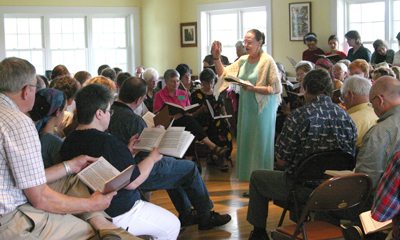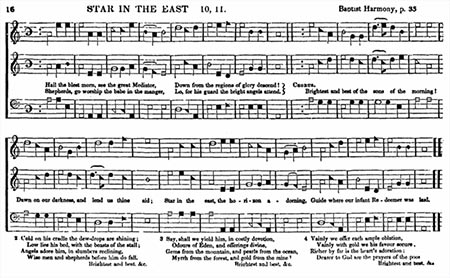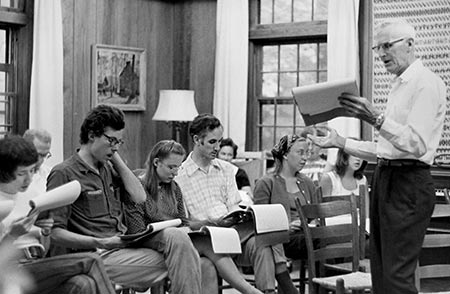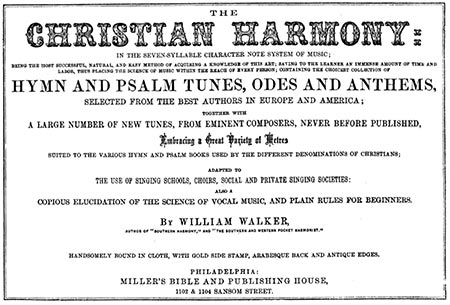
29 Jun Becky Walker & Shape Note Singing
Every summer in July a unique and wonderful event occurs at the Folk School. The Annual Shape Note Singing draws more than 70 singers from four states for a day of powerful vocal harmonizing.
Is this a secret club where only tenured and experienced singers can gather?
Absolutely not! Anyone can come to participate, observe, and experience the power of Shape Note Singing. Come join us on July 6 from 10:30 a.m. to 3 p.m. in the Music Studio, Davidson Hall. The Folk School Sing welcomes beginners and with no musical experience or religious affiliation required. Admission to the singing is free.
What is Shape Note Singing? Shape Note Singing is an American tradition that brings people together to sing four-part hymns. Big Hollywood movies like Lawless and Cold Mountain feature scenes with Shape Note Singing bringing it to eye of our wider culture. To get a audible flavor of the Shape Note Singing style, watch the trailer (see below) for the 2007 documentary movie Awake, My Soul: The Story of the Sacred Harp.
(Please Note: at the Folk School Shape Note Singing, we use Christian Harmony, a 7-shape notation system & Sacred Harp as depicted in the documentary below is a 4-shape notation. They are both different types of Shape Note Singing.)
I sat down with Becky Walker, Folk School instructor and tenured Shape Note enthusiast, to find out more about the annual Shape Note Singing the Folk School…
CP: Can anyone sing? What do you need to know to participate?
BW: Sings are open to all – you don’t have to know the system – you just sit in a section, give it a try, and be willing to be swept along by the power of the music.
CP: Do you have to be able to read music to sing?
BW: The ability to read music can help someone figure out a part, however, that knowledge sometimes inhibits the actual learning of the system. You might have to put aside your musical education for a bit. This is especially true of people who have “perfect pitch” since the songs are usually not sung exactly in the pitch where they are written – the pitch is determined by the voices present, and it can be raised or lowered to suit the group. If the Basses and Trebles are happy, everyone else is, too!
CP: Do you use the standard black oval-shaped musical notes that we are all familiar with?
BW: In Shape Note Singing, each degree or note of the scale has a different shape – instead of the regular round notes we now know. That round shape that you think of when you think about music notes is reserved for “sol” which is the 5th tone of the scale.
CP: How did you discover with Shape Note Singing?
BW: Steve’s (Becky’s husband) first encounter was at dance weekends and fiddle conventions – often a Sunday morning activity or presentation. He’d heard some of the music when he was a kid in Alabama. I’d never heard or heard of it until I met him.
CP: How long has Shape Note singing been going on at the Folk School?
BW: I don’t know when the first singing at the Folk School was, but I do remember several years of singing in Keith House before Davidson was built. The sound in there was great, but the light was poor. This was when we were still using the old books. (NOTE: After some research we discovered this year’s sing will be the 21st Annual Shape Note Singing at the Folk School)
CP: What can you expect at the Annual Shape Note Singing?
BW: The Folk School Singings are always good – lots of strong singers from all over…NC, SC, GA, AL, TN, and sometimes further away. Through the years, many of the “old timers” (I guess that’s us now!) would come, and I can still feel their presence when we sing their songs. I remember one occasion where four generations of a family was represented – there are still folks around who grew up singing this music.
CP: Do people ever sing with accompaniment – or is it always a capella?
BW: Traditionally, this was a system for sight reading music for a capella singing – but many people have put musical accompaniment for performance. I don’t think this would happen at a regular singing.
CP: Is Shape Note Singing a Southern/Appalachian tradition?
BW: Shape Note Singing is not a Southern Appalachian tradition – there are several traditions all over the country – many in the Northeast, Midwest and Deep South use the four-note system, called Fa Sol La or Sacred Harp. We use the seven note system, called Christian Harmony, which is more common in our part of the South. I think the tradition caught on and lasted in the South for several reasons: lack of musical education and a shortage of musical instruments, especially in rural churches, the popularity of singing schools, and the routes of traveling hymn book salesmen that brought the music into small and isolated communities.
For more information about the Folk School Shape Note Singing visit our event page.
Becky, a wool worker from way back, discovered felt making at the Folk School. An advocate of the folk process, she enjoys combining traditional techniques and innovative ideas. Becky is on the South Carolina Arts-in-Education roster of approved artists for felt making and traditional music and dance. She and her husband, Steve, founded their local community dance and teach workshops in shape-note singing.









wayne richard
Posted at 09:50h, 04 JulyThe tradition is Shaped Note Singing, with a “d” on Shaped. Nice interview…I can hear Becky’s voice. Also, as others have probably mentioned, Sacred Heart, in the intro, should be Harp.
Cory Marie Podielski
Posted at 16:58h, 13 JulyThanks Wayne! I made the correction to “Harp,” glad you caught it. The Folk School Sing is called the “Shape Note Singing” so that is why I referred to the tradition the way I did, without the “d.” I will ask the Folk School Music Coordinator about it. Thanks!